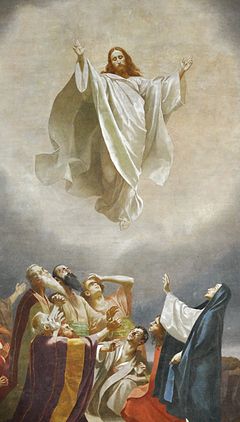Ascension Thursday
| Ascension Day | |
|---|---|

Christi Himmelfahrt by , c. 1893
|
|
| Also called | Holy Thursday Ascension Day Ascension Thursday |
| Observed by | Christians |
| Type | Christian |
| Significance | commemorates the Ascension of Jesus into heaven |
| Observances | Service of Worship / Mass |
| Date | 39 days after Easter (Western) |
| 2016 date |
May 5 (Western) June 9 (Eastern) |
| 2017 date |
May 25 (Western) May 25 (Eastern) |
| 2018 date |
May 10 (Western) May 17 (Eastern) |
| 2019 date |
May 30 (Western) June 6 (Eastern) |
| Frequency | annual |
| Related to | Easter, Pentecost |
May 5 (Western)
May 25 (Western)
May 10 (Western)
May 30 (Western)
The Feast of the Ascension of Our Lord and Savior Jesus Christ, also known as Ascension Thursday, Holy Thursday, or Ascension Day, commemorates the Christian belief of the bodily Ascension of Jesus into heaven. It is one of the ecumenical feasts (i.e., universally celebrated) of Christian churches, ranking with the feasts of the Passion, of Easter, and Pentecost. Ascension Day is traditionally celebrated on a Thursday, the fortieth day of Easter (following the accounts given in Mark 16:19, Luke 24:51, Acts 1:2 ), although some Christian denominations have moved the observance to the following Sunday.
The observance of this feast is of great antiquity. Eusebius seems to hint at the celebration of it in the 4th century. At the beginning of the 5th century, St. Augustine says that it is of Apostolic origin, and he speaks of it in a way that shows it was the universal observance of the Church long before his time. Frequent mention of it is made in the writings of St. John Chrysostom, St. Gregory of Nyssa, and in the Constitution of the Apostles. The Pilgrimage of Aetheria speaks of the vigil of this feast and of the feast itself, as they were kept in the church built over the grotto in Bethlehem in which Christ is traditionally regarded as having been born. It may be that prior to the 5th century the fact narrated in the Gospels was commemorated in conjunction with the feast of Easter or Pentecost. Some believe that the much-disputed forty-third decree of the Synod of Elvira (c. 300) condemning the practice of observing a feast on the fortieth day after Easter and neglecting to keep Pentecost on the fiftieth day, implies that the proper usage of the time was to commemorate the Ascension along with Pentecost. Representations of the mystery are found in diptychs and frescoes dating as early as the 5th century.
...
Wikipedia
